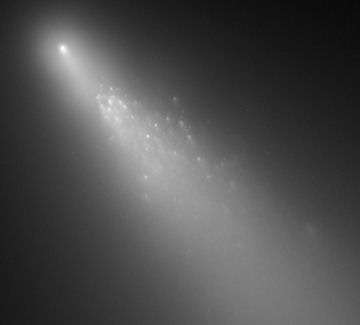When comets pass close to the sun, solar radiation can bake and chemically alter their outer layers. Yet new observations of fragments of a comet that broke apart almost in front of astronomers’ eyes suggest that its interior was remarkably similar to its exterior.

For comets, breaking up isn’t hard to do. Relics of the solar system’s formation, these fragile amalgams of ice, rock, and dust can burst into fragments when the sun’s heat vaporizes some of their icy material.
By observing such fragments, astronomers can compare material disgorged from a comet’s core with the presumably sun-altered material at its surface. Theory suggests that these changes ought to be significant, especially for comets that frequently pass near the sun. That’s why scientists were surprised to find that two recently separated chunks have highly similar compositions.
If that observation is representative of comets in general, it suggests that at least some of these frozen bodies may preserve much more of their primordial composition than astronomers have generally believed, says Neil Dello Russo of the Johns Hopkins University’s Applied Physics Laboratory in Laurel, Md. He and his colleagues describe their study of two large fragments of a comet called 73P/Schwassmann-Wachmann 3 (SW3) in the July 12 Nature.
The comet, which orbits the sun every 5.34 years, split into at least five chunks in 1995. In June 2006, it passed within 11.7 million kilometers of Earth, just as it further disintegrated into 68 identifiable pieces (SN: 5/6/06, p. 277).
The two largest chunks, dubbed B and C, are each several hundred meters in diameter. Russo are his colleagues took spectra of these fragments with NASA’s Infrared Telescope Facility and the Keck II telescope, both on Hawaii’s Mauna Kea. The measurements, the most accurate ever obtained for a disintegrating comet, reveal that B and C have virtually identical relative abundances of many simple compounds, including water, the hydroxyl molecule, and carbon dioxide.
“We were really lucky” that the comet came close enough for astronomers to make observations soon after a breakup, says Russo. Because such compositional information hasn’t been obtained for other fragmenting comets, it’s difficult to determine how broadly the findings apply, he cautions.
Previous measurements of other fragmenting comets had hinted at a uniform composition, says comet scientist Michael F. A’Hearn of the University of Maryland at College Park. Researchers are trying to determine whether the diversity of dust particles observed after NASA’s Deep Impact spacecraft blasted a hole in Comet Tempel-1 is the result of recent exposure to the sun or represent primordial variations in the comet’s composition (SN: 9/10/05, p. 168).
The bottom line, says A’Hearn, is that while the new findings on SW3 “may [indeed] be suggesting that comets might be homogeneous . . . I’m not yet ready to tilt in favor of that hypothesis.”







